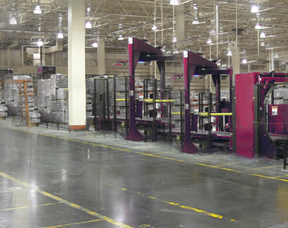 From time to time you may be called upon to stripe cement warehouse or factory floors or cement parking lots. Inside warehouses, regulatory agencies require that floors be marked for safety purposes. Striping cement floors is always a challenge for a few reasons. These reasons are: slick cement, curing compounds, grease and dirt. The good news is that with a little preparation, these issues can be offset. The first thing you want to do is test the surface.
From time to time you may be called upon to stripe cement warehouse or factory floors or cement parking lots. Inside warehouses, regulatory agencies require that floors be marked for safety purposes. Striping cement floors is always a challenge for a few reasons. These reasons are: slick cement, curing compounds, grease and dirt. The good news is that with a little preparation, these issues can be offset. The first thing you want to do is test the surface.
Water Test – To see if the concrete surface you need to stripe is ready for paint or thermoplastic you can use this basic test. Take one tablespoon of water and apply it to the floor. If the water it soaks in in just a few second then your floor is porous enough to accept a coating. If it sits there for several minutes then paint or thermoplastic will not perform well since it cannot grab the surface or soak in. Keep in mind that if water can’t soak in then the paint will not either.
Problems –
First, warehouse and factory floors are generally smooth much like your garage or house foundation floor. The finishing process that is used to smooth the cement to a slick finish closes the pores in the cement and prevents moisture from soaking into the floor like it would on say a driveway or other rougher cement surface. The problem that this creates for striping is that the paint has little to grab and subsequently will begin to flake or chip off. This problem is accelerated by forklift and equipment traffic.
Second, when cement is poured a curing compound is often used to help the concrete hold in moisture so that it cures slow and gains proper strength. This compound is present on the surface of the foundation and remains indefinitely. The curing compound can prevent paint or thermoplastic from adhering to the surface.
Third, over time cement becomes dirty and greasy. These types of surfaces tend to not hold paint well.
Solutions –
The problem of slick cement or curing compounds can be overcome via the use of a concrete grinder or scarifier. These machines take off from 1/16 to 1/8 of an inch of cement. This removes the top layer of the cement that would have the most curing compound in it and also roughs up the surface so that paint can grab it. Running a grinder or scarifier over the areas where you want lines will increase paint and thermoplastic adhesion substantially. After you scarify a strip for painting you can try the water test again. At this point the water should soak in to the cement more quickly than before.
Dirty and greasy cement can be cleaned using a degreasing compound and a pressure washer. You can also use a degreaser, a scrubber and a water hose. Once the surface is clean just let it dry for a few days and then apply your paint.
Steven Cole (Economics, MBA – University of West Florida, Business & Innovation – Stanford University) 30 years experience in the parking lot striping business. Expert in reflective visibility solutions.